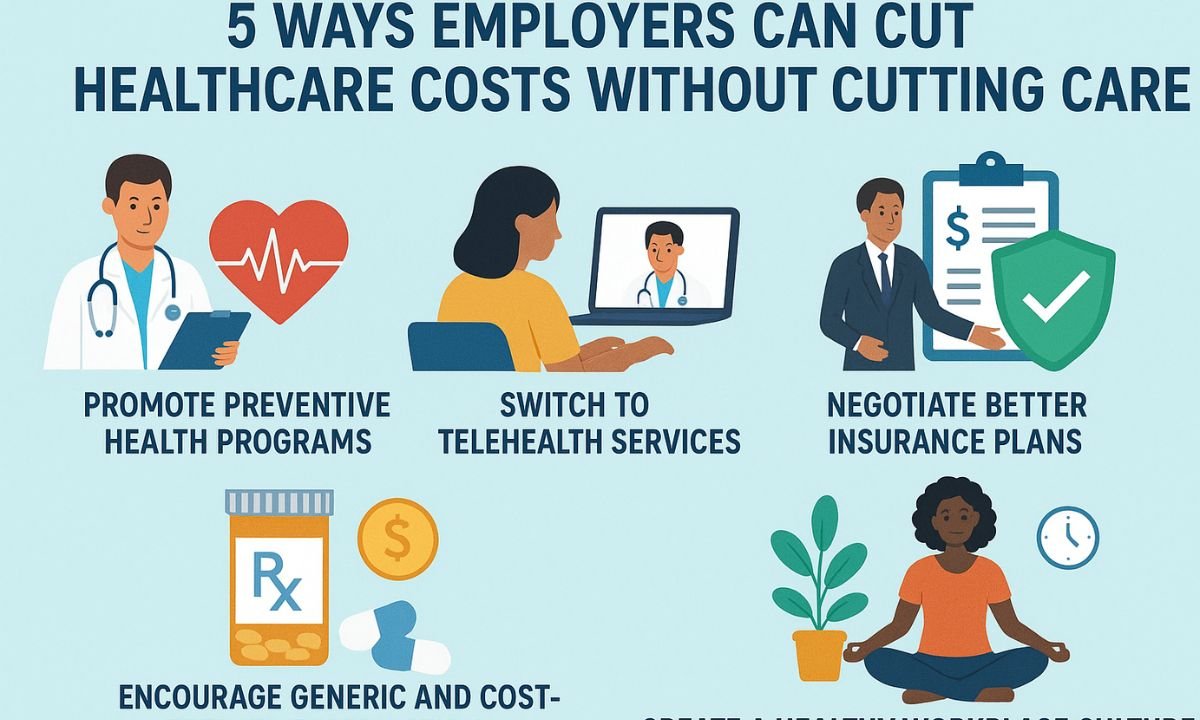Let’s be honest — healthcare costs are climbing every year, and employers are feeling the pressure. But reducing these costs doesn’t mean you have to reduce the quality of care your employees receive. In fact, smart strategies can help companies save money and keep employees healthier and happier.
Let’s explore five practical ways employers can cut healthcare costs without cutting care.
Understanding the Rising Cost of Healthcare
Healthcare costs are increasing due to expensive medical treatments, prescription drugs, and chronic diseases like diabetes and heart problems. For employers, these rising expenses can affect profit margins and employee satisfaction. But there’s good news — with a few proactive steps, you can reduce costs while maintaining great care.
Why Cutting Costs Doesn’t Mean Cutting Care
Many employers think saving money means cutting benefits. That’s not true. Cost reduction can come from smarter management, prevention, and better use of available healthcare resources. The goal is not to reduce what employees get but to improve how it’s delivered.
Promote Preventive Health Programs
Encourage Regular Health Checkups
Regular checkups help detect health issues early when they’re easier (and cheaper) to treat. Employers can offer free annual screenings or health fairs to encourage participation. Early prevention means fewer emergencies and lower overall costs.
Offer Wellness Challenges and Incentives
Make health fun! Create company fitness challenges, offer step-tracking rewards, or provide discounts for gym memberships. These small programs can lead to big health improvements and cost savings over time.
Benefits of Preventive Care for Employers
Preventive programs reduce absenteeism, boost morale, and lead to a healthier workforce. In short, healthier employees mean lower insurance claims and fewer sick days.
Switch to Telehealth Services
Lower Consultation Costs
Telehealth allows employees to consult doctors online, saving both time and money. Virtual visits are often cheaper than in-person appointments, and they help reduce unnecessary hospital trips.
Better Access to Healthcare for Employees
Employees can get medical advice anytime, anywhere — even during lunch breaks. This accessibility increases satisfaction and helps them seek care before problems get worse.
How Telehealth Improves Productivity
When employees can see a doctor quickly and easily, they spend less time away from work. That means fewer missed days and higher productivity.
Negotiate Better Insurance Plans
Partner with Insurance Brokers
Instead of sticking with the same plan every year, employers can work with insurance brokers to compare offers and negotiate better deals. This can lead to lower premiums without sacrificing benefits.
Compare and Customize Plans
Different employees have different healthcare needs. Offering multiple plan options gives flexibility and helps control costs. For example, younger workers might prefer lower premiums with higher deductibles.
Focus on High-Value Care
Encourage employees to use healthcare services that provide the best results at reasonable prices. High-value care focuses on quality rather than quantity, ensuring money is spent wisely.
Encourage Generic and Cost-Effective Medications
Educate Employees on Generic Alternatives
Many brand-name drugs have generic versions that cost much less but work just as effectively. Employers can educate staff about these options through workshops or newsletters.
How Employers Can Help Manage Prescriptions
Partner with pharmacies or use online platforms to compare prices. Providing employees with easy access to affordable medication options reduces their out-of-pocket costs and lowers insurance claims.
Create a Healthy Workplace Culture
Promote Mental Health Support
Mental health affects productivity and healthcare spending. Offering counseling, stress management programs, and mental health days can prevent burnout and long-term issues.
Encourage Physical Activities and Breaks
Simple initiatives like walking meetings or standing desks promote movement during work hours. Physical activity reduces stress and prevents health issues, leading to fewer doctor visits.
Why a Healthy Culture Saves Money
A supportive, healthy workplace builds loyalty and reduces turnover. When employees feel cared for, they perform better and take fewer sick days — saving the company money in the long run.
Conclusion
Cutting healthcare costs doesn’t have to mean cutting care. By focusing on prevention, modern tools like telehealth, and promoting healthy lifestyles, employers can create a win-win situation — saving money while keeping their teams strong and motivated. The key is to invest in smarter healthcare solutions, not cheaper ones.
FAQs
What is the best way to reduce employer healthcare costs?
Encouraging preventive care and offering telehealth options are among the most effective methods.
Do wellness programs really save money?
Yes, they help prevent chronic diseases and reduce medical claims over time.
How can telehealth benefit small businesses?
It offers affordable healthcare access without expensive insurance upgrades.
Are generic drugs safe for employees?
Absolutely. Generic medicines are approved and have the same active ingredients as brand-name drugs.
Can a healthy work culture lower healthcare costs?
Yes, employees who feel supported and stay healthy file fewer insurance claims.










